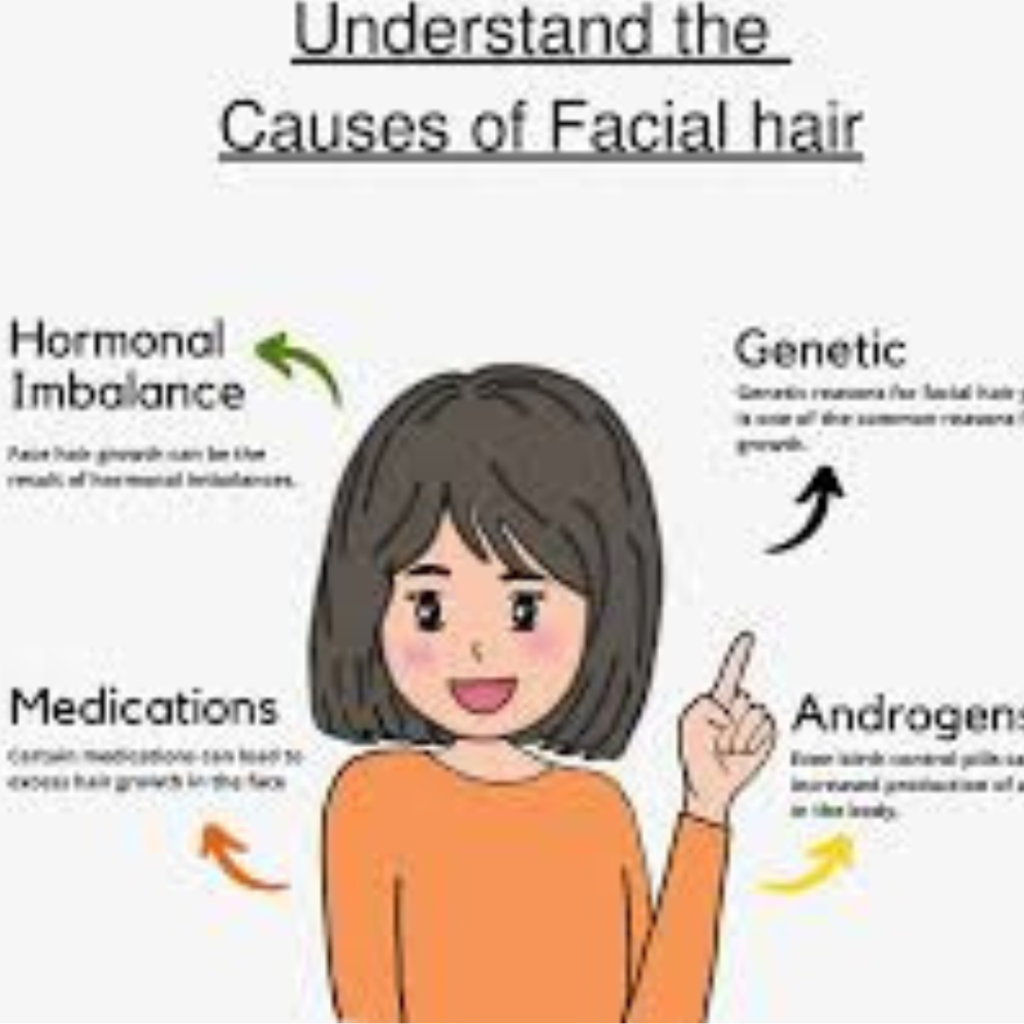Permanent Facial Hair Removal for Women? Tweezers and razors just won’t cut it (literally). Find a lasting solution to smooth, hair-free hair!
Causes Of Facial Hair

Facial hair growth is a natural occurrence for everyone, regardless of gender. However, some women may experience excessive growth due to various factors. Here’s a look at the main underpinnings Permanent Facial Hair Removal for Women: Solutions That Last :
Hormonal Imbalances: Androgens, often referred to as male hormones, are present in both men and women. In women, these hormones are typically produced in low levels. However, an imbalance can lead to increased facial hair growth. Polycystic ovary syndrome (PCOS) and Cushing’s syndrome are two conditions that can cause hormonal imbalances Permanent Facial Hair Removal for Women.
Medications: Certain medications, such as anabolic steroids and some birth control pills, can have side effects that include increased hair growth.
Genetics: Just like other physical characteristics, facial hair growth can be influenced by your genes. If you have a family history of excessive hair growth, you may be more likely to experience it yourself.
Ethnicity: Ethnicity can also play a role. Women of Mediterranean, Middle Eastern, and South Asian descent are more likely to have coarser and darker facial hair.
Additional Factors

In addition to the main causes mentioned above, there are a few other factors that can contribute to Permanent Facial Hair Removal for Women:
- Insulin resistance: This can be a contributing factor in PCOS and can also play a role in hirsutism independently.
- Metabolic syndrome: A cluster of conditions including high blood pressure, high blood sugar, and unhealthy cholesterol levels, which can sometimes be linked to hormonal imbalances and increased facial hair growth.
- Stress: Chronically high stress levels can disrupt hormone production and may worsen symptoms of PCOS or other underlying conditions that contribute to hirsutism.
- Aging: After menopause, some women experience an increase in facial hair due to a natural shift in hormone balance.
It’s important to note that sometimes there’s no identifiable cause for excessive facial hair growth. If you are concerned about excessive facial hair growth, it is best to consult with a doctor to rule out any underlying medical conditions.
Types of Hirsutism

Hirsutism can be classified into different categories based on its underlying cause and presentation. Here’s an overview of the main types:
Idiopathic: Most common, with no apparent cause (likely genetic or hormonal).
Hormonal: Due to imbalances such as PCOS or adrenal problems.
Drug-induced: side effects of certain drugs.
Tumor-related: Rare, caused by androgen-producing tumors.
Cushing’s syndrome: High cortisol levels can be caused by tumors or medications.
It’s important to note that hirsutism can sometimes be caused by a combination of factors, making it challenging to pinpoint a single underlying cause.
Unraveling the Root Cause: How Medical Conditions Impact Hair Growth
Excessive facial and body hair growth can be a frustrating issue for many women. While some may simply have a genetic predisposition, others may have an underlying medical condition contributing to the problem. Here’s a quick overview of some common culprits:
1. Polycystic Ovary Syndrome (PCOS):
This hormonal imbalance is a leading cause of hirsutism (excessive hair growth). PCOS disrupts ovulation and menstrual cycles, leading to increased androgen (male hormone) levels. These elevated androgens contribute to unwanted hair growth.
2. Weight Management:
For women with PCOS, maintaining a healthy weight can be particularly helpful. Studies show that weight loss can improve insulin sensitivity and lower androgen levels, leading to a reduction in symptoms like hirsutism.
3. Addressing the Underlying Condition:
The most effective approach often involves addressing the root cause. For PCOS, treatment may include birth control pills to regulate hormones, medications to reduce androgen production, or drugs like metformin to manage insulin resistance. In some cases, surgery may be considered to remove large cysts.
Key Takeaway:
Early diagnosis is crucial. If you’re concerned about excessive hair growth, consult a doctor to determine the underlying cause and develop a personalized treatment plan.
Permanent Facial Hair Removal Here are the 10 ways:
Natural Hair Removal Remedies: A Quick Guide
Here’s a rundown of some natural hair removal methods you can try at home:
- Chickpea Flour Magic: Mix chickpea flour, turmeric, cream, and milk for a paste. Apply, wait, rub off (opposite hair growth!), and rinse. Use twice a week for the better results.
- Papaya Power: Blend papaya, turmeric, and aloe vera gel into a paste. Apply, let dry, and rub off (opposite hair growth!).
- Gram Flour Glow: Mix gram flour, rose water, and lemon juice for a paste. Apply, let dry completely, and rub off in circles.
- Lemon Lightening: Mix lemon juice and honey for a lightening paste. Apply, let dry, and rinse. Be careful, lemon can bleach!
- Banana Buff: Mash a banana with oatmeal for a scrub. Massage onto face, let dry, and rinse. Use twice a week for the bestest results.
- Rice Power: Mix rice flour, turmeric, and milk into a paste. Apply, let dry completely, and rinse with lukewarm water.
- Rosewater Rejuvenation: Mix rosewater, olive oil, and powdered alum (dissolve first!) into a paste. Apply layers (6 total), let dry, and wash off. Moisturize afterwards.
- Eggcellent Exfoliation: Mix sugar, cornflour, and an egg for a paste. Apply, let dry, peel off gently, and repeat thrice a week.
- Barley Bliss: Mix barley powder, milk, and lime juice for a paste. Apply it , let it dry, and rinse with lukewarm water.
- Gelatin Grab (Caution): Mix gelatin powder, milk, and lemon juice. Heat briefly, cool, apply, wait, and peel off. Avoid if you have sensitive skin.
Remember: These are home remedies, and results may vary. Always do the patch test before applying to your entire face or a body part. Consult a dermatologist for more permanent solutions.
